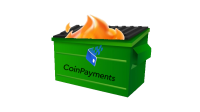Latest User Testimonial
Just the bookkeeping solution i needed
I've been needing to keep up with my personal finances, but i never got around to it until trying fl...
Latest flowlog News

Coinpayments.net Ends Service for US Customers
Coinpayments.net is ending service for US customers. This affects certain flowlog billing features....
Visitor Feedback
Issue with flowlog.net? Is flowlog missing a critical feature? Something else?
Bad Debt
If you have been using flowlog’s Billing Feature Set, you may have noticed this “Bad Debt” button on the Invoices page, next to any unpaid Invoice.
flowlog’s Bad Debt feature uses the Direct Write-Off method, where money from Accounts Receivable is accepted as being un-collectible and which we want to write off our books.
When you click this “+ Bad Debt” button, flowlog automatically credits (reduces) your accounts receivable (current asset) account and debits (increases) your bad debt (expense) account. This will prevent any accidental overspending, since you’ll see what income you are actually receiving and how much you really have in your asset accounts.
You also get a clear picture of how much you need to make to cover your losses. For instance, if you write off $2,000 in debt this year and operate on a 10 percent profit margin, you will have to sell $20,000 to make up for the bad debt.
Recording Bad Debt may also be necessary if you ever need a bank loan, as they will want accurate financial history including your cash flow, assets, expense activity, etc.
Another added benefit in recording Bad Debt is you can write it off as a tax deduction. Bad debt may include loans to clients and suppliers, credit sales to customers, and business-loan guarantees.
Furthermore, this feature can facilitate preventative actions, since seeing a big “ + Bad Debt” button next to an invoice will certainly remind you to follow up on all past due invoices.
To use this feature, we will need to set up a Bad Debt account in our Accrual set of books. The Bad Debt feature is not enabled for a set of books using the Cash Method, because with the Cash Method, income is not put on the books until it has actually been received/paid. As you can see, I already have a Bad Debt account set up, but let’s assume I didn’t for this example.
On your Accounts page we will select “+ New Account”, and name it “Bad Debt” or whatever name is most appropriate for your business.
This account will need to be under “Indirect Expenses” which will be a “Debit” account.
Leave the Cash Flow fields as “not applicable”.
This is not a depreciable asset account so choose “no”.
Then, where it says “Bad Debt Expense Account” we will select “yes”.
You can add any help text for this account if you like, which might be useful if you have someone else helping with managing your books, or if it’s been a while and you forget.
Lastly, make sure to click “save”.
Once that is done we can go back to the Invoices page. Now, whenever you need to write off an unpaid Invoice as Bad Debt, you don't have to hassle with manually creating entries. Just click “Bad Debt” and flowlog will create the necessary bookkeeping entries for you.
In some other programs, once you write off an invoice as Bad Debt, by creating the entries manually, deleting the Invoice, or some other means, the Entries have been created, but now the Invoice is gone. To find out if a customer is in good standing, you might have to go to the Bad Debt Account, search through Entries, and then manually associate those with Invoices. In flowlog, not only is the Invoice linked from the Entry, the Invoice itself moves to the bottom of the Invoices page under “+ Bad Debt” so you have easy access to Bad Debt Invoices, what the Invoices were for, and the clients associated with them.
That's all there is to it. Hopefully you’ll always be paid in a timely fashion, but if not, it just takes one click and you are done.
Thanks for watching!
Comments
No existing comments found for this screencast.
